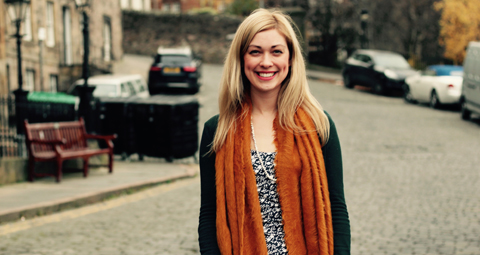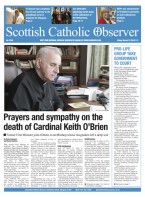March 16 | ![]() 0 COMMENTS
0 COMMENTS ![]() print
print

The prime of Catholic imagination
RICHARD PURDEN speaks to author Linden Bicket about the forgotten religious influences on some of Scotland’s most iconic literature - By RICHARD PURDEN
Linden Bicket, a teaching fellow at the School of Divinity in Edinburgh, is a vividly bright, refreshing Scottish Catholic thinker, who has shaken up the often masculine and staid world of academia with her new book George Mackay Brown and the Scottish Catholic Imagination.
Beyond an enlightening study of Mackay Brown’s key works, the book considers the fiction of other well-known Catholic converts such as Muriel Spark and the less-known cradle Catholic George Friel.
Bicket suggests that the Catholic imagination in Scotland has been shaped by ‘the tumultuous religious history of the nation.’
The Scottish Reformation, she argues, was seen by many writers as a ‘culturally damaging act.’ Beyond the history of Irish Catholic immigration, she believes there are other factors in need of consideration when exploring what formed the Catholic mind in Scotland.
“Catholic imagination is shaped by various geographical and cultural factors; there is a global grammar across the world which tends to draw on the Sacramental system of the Catholic Church,” she said. “It’s a sacramental way of seeing the world where
everything is alive with the purpose and presence of God and that makes it very pictorial and visual.
“The material world is a good place and trusted as not fallen and riven through with sin but as something we can trust.”
The study also reflects on the distinctive and often difficult history which has shaped Catholic life and thinking. “There is a really interesting dialogue with Scotland’s Calvinist formation history and trajectory with Protestant heroes, the Covenanters and Robert Burns which makes it quite different from English writers such as Evelyn Waugh and Graham Green. There’s more focus on class than a history full of battles, folklore and bogles.”
Significantly our meeting begins at John Knox’s statue outside New College overlooking Edinburgh’s majestic Mound, but attention is soon turned from Knox to Mackay Brown and the striking Catholic image on the cover of Ms Bicket’s vibrant new work.
“It’s a beautiful, stern, moving image appropriate to Orkney and Europe,” she explained. “It has a young George Mackay Brown looking on wistfully. He has this outsider status in the image. There’s space between him and the Crucifix outside the Italian Chapel which also says something about the duel focus of Rome and Scotland.”
Her enthusiasm for Mackay Brown’s writing is palpable and the Orcadian’s work, among others, sparked a passion for Catholic life and imagination in literature as well strengthening a personal Faith. “As I progressed in my studies I was drawn to writers like John Donne, Gerard Manley Hopkins and particularly medieval writers and devotional works. [With Donne] there was a window onto his life and soul which spoke to me.
“As an undergraduate I read Mackay Brown’s Andrina. It’s a ghost story about the Sacrament of Reconciliation, human weakness and atonement. I suppose he felt the Catholic Church provided more than provision for sin (in comparison with Calvinist theology). The old man in the story is visited by a woman who turns out to be the ghost of a granddaughter he’s never met due to the misdeeds of a wild youth.
“There is a lovely portrayal of forgiveness and grace. After that I traced more of Mackay Brown’s work and legacy which helped inform my own Faith as well.”
This month marked 100 years since Muriel Spark’s birth in Edinburgh. The sense of a complicated religious and class division in Edinburgh is bestsummoned in her most loved and critically acclaimed novel The Prime of Miss Jean Brodie.
“Miss Brodie is a kind of Mary Queen of Scots figure,” Bicket said. “She has a kind of Catholic glamour and is highly visual. It’s read by some as being about class rather than religion but in fact it’s quite a Catholic story.
“When she takes the girls to a Catholic ghetto it marks out a moment for the character Sandy Stranger. Catholicism is seen as something dangerous, attractive, romantic and thrilling. In a sense, travelling through that Irish ghetto in Edinburgh is a first step towards God. It is almost as if this character goes through the Stations of the Cross.”
Significantly, Sandy rejects Calvinism and the theology of pre-destination ultimately for a Catholic Faith, but it’s a troubled journey which involves an affair with a married Catholic teacher with six children.
“Sandy is a bit of a sinister character,” Bicket said. “Spark is suggesting in her very Catholic and novelistic way that good can come from evil—there’s some authorial strategy to show this series of steps on the way to God and the ‘misty region of crime of desperation’ is the first station for that character who eventually becomes a nun.”
Bicket’s book suggests that there are a number of Scottish Catholic writers who have been ‘neglected,’ among them George Friel (1910-75), who was educated at St Mungo’s Academy and worked as a teacher in his home city of Glasgow. She describes him as one of Scotland’s three best short story writers along with Mackay Brown and Spark.
“I really don’t want to underplay his talent—along with Spark he stands head and shoulders above the rest. His father was from Donegal and he was brought up in a room-and-kitchen tenement on Maryhill Road. He wrote about Glasgow the way James Joyce wrote about Dublin and planned a collection of short stories about Glasgow in a Dubliners style. The output is not huge and his novels The Boy Who Wanted Peace, Grace and Miss Partridge and Mr Alfred, M.A. don’t receive much attention, but he is a wonderful writer and we need to hear more about him.”
At Bicket’s recent book launch, Church of Scotland minister Ron Ferguson referred to Mackay Brown’s deep passion for Celtic Football Club.
Bicket jocularly suggested the writer and poet was ‘obsessed with Celtic’ but adds that ‘the sense of belonging, community and being in a relationship with people is a really positive aspect’ of support at the club. For many, religion and football don’t mix, but perhaps for a club with the Catholic religion at its root that can also be redeemed. Faith can be linked to Celtic without being labelled ‘sectarian.’
“I think Mackay Brown saw it as being part of a broader society,” Bicket said. “There are others who share something with you. Religion and football are there. They are part of history and there is an opportunity for dialogue and relationship. It can be reclaimed in a good and inclusive way.”
– For more on George Mackay Brown and the Scottish Catholic Imagination by Linden Bicket visit: edinburghuniversitypress.com











